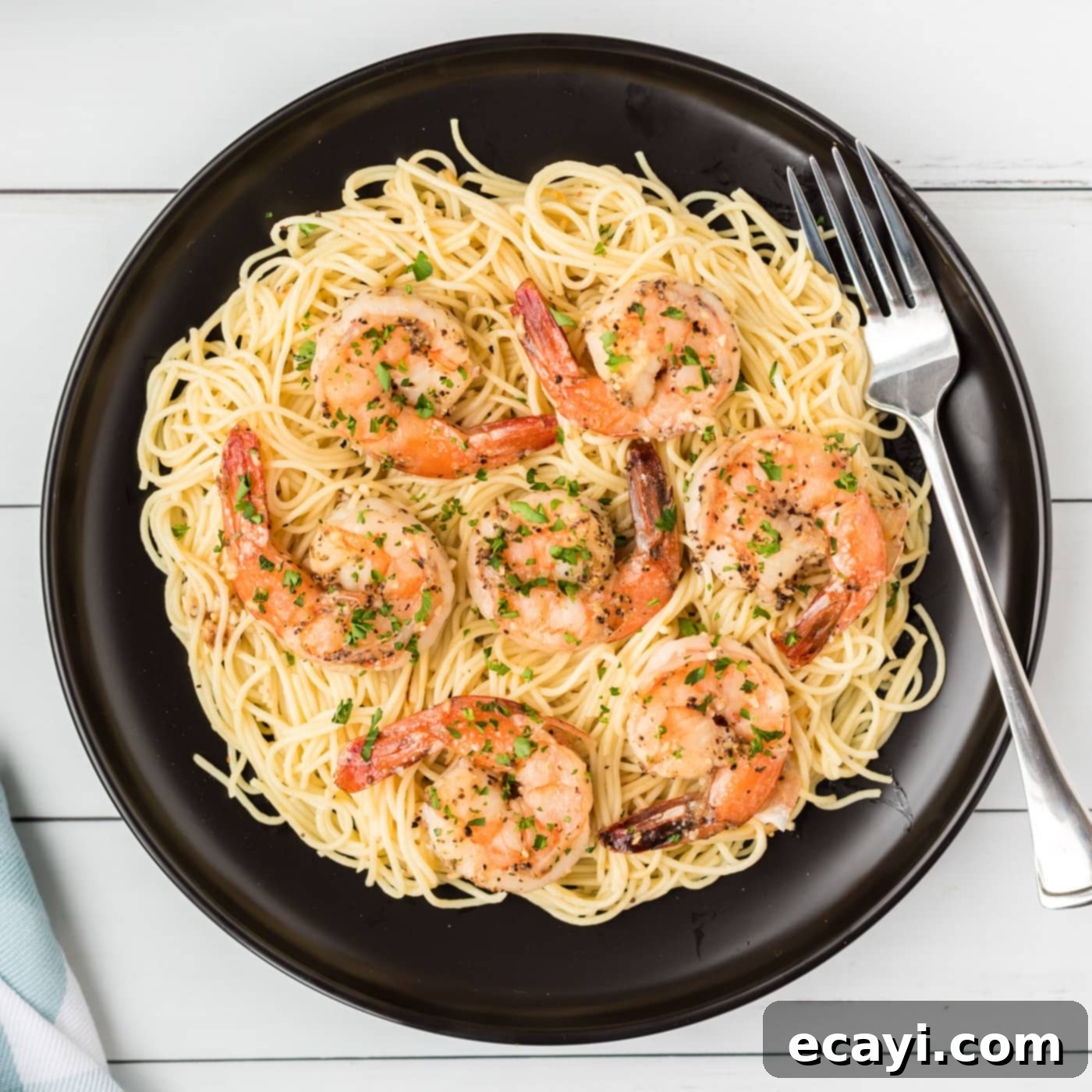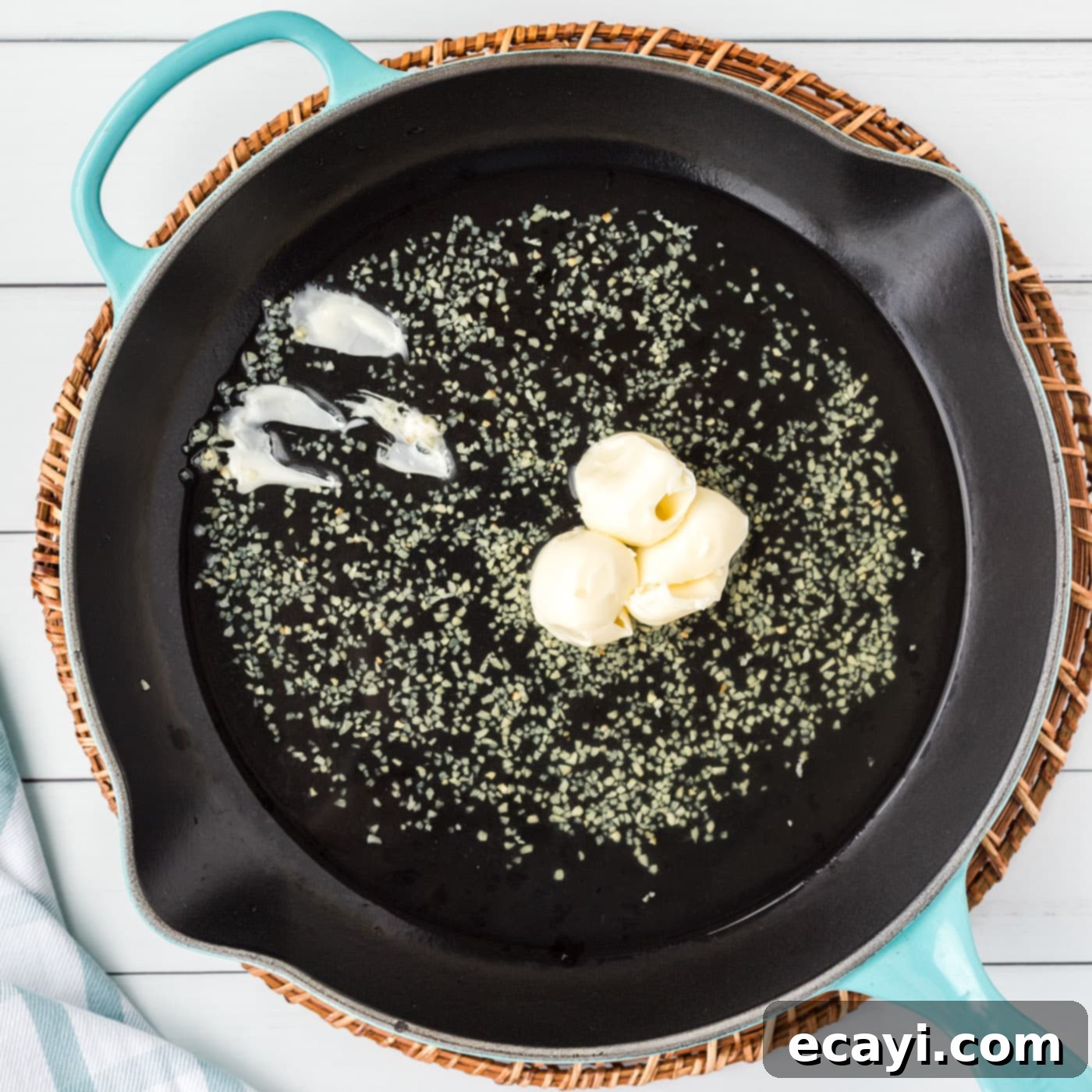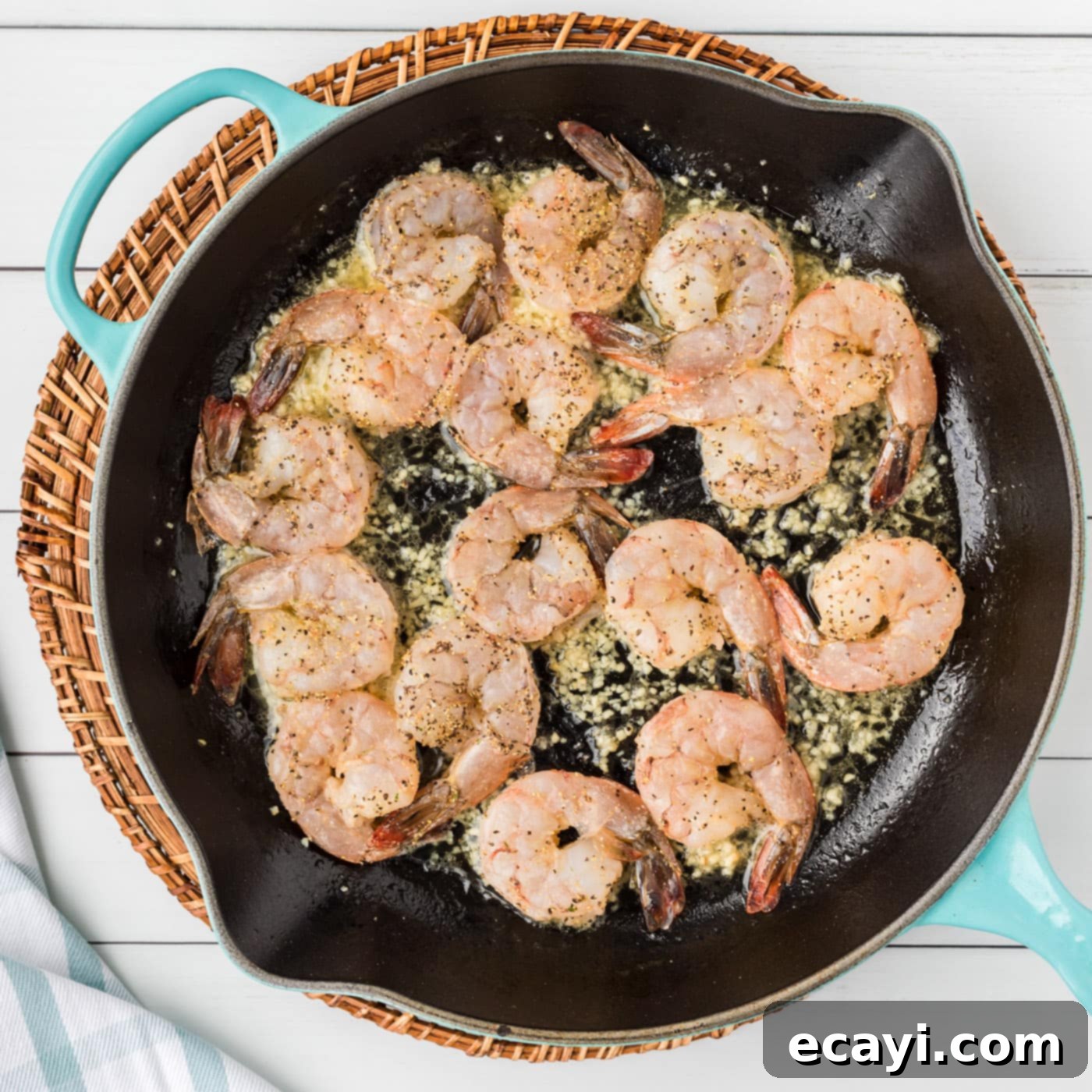Irresistibly Easy Shrimp Scampi Pasta: Your Go-To Weeknight Dinner
Craving a dish that’s both elegant and incredibly simple to make? This delightful Shrimp Scampi Pasta is exactly what you need. It features succulent, juicy shrimp sautéed to perfection in a rich and aromatic sauce made from white wine, fresh garlic, bright lemon juice, and luscious butter. Finally, this heavenly combination is tossed with delicate angel hair pasta, creating a truly irresistible meal that comes together in a flash. Perfect for a quick weeknight dinner or an impressive meal for guests, this recipe promises to be a staple in your culinary repertoire.
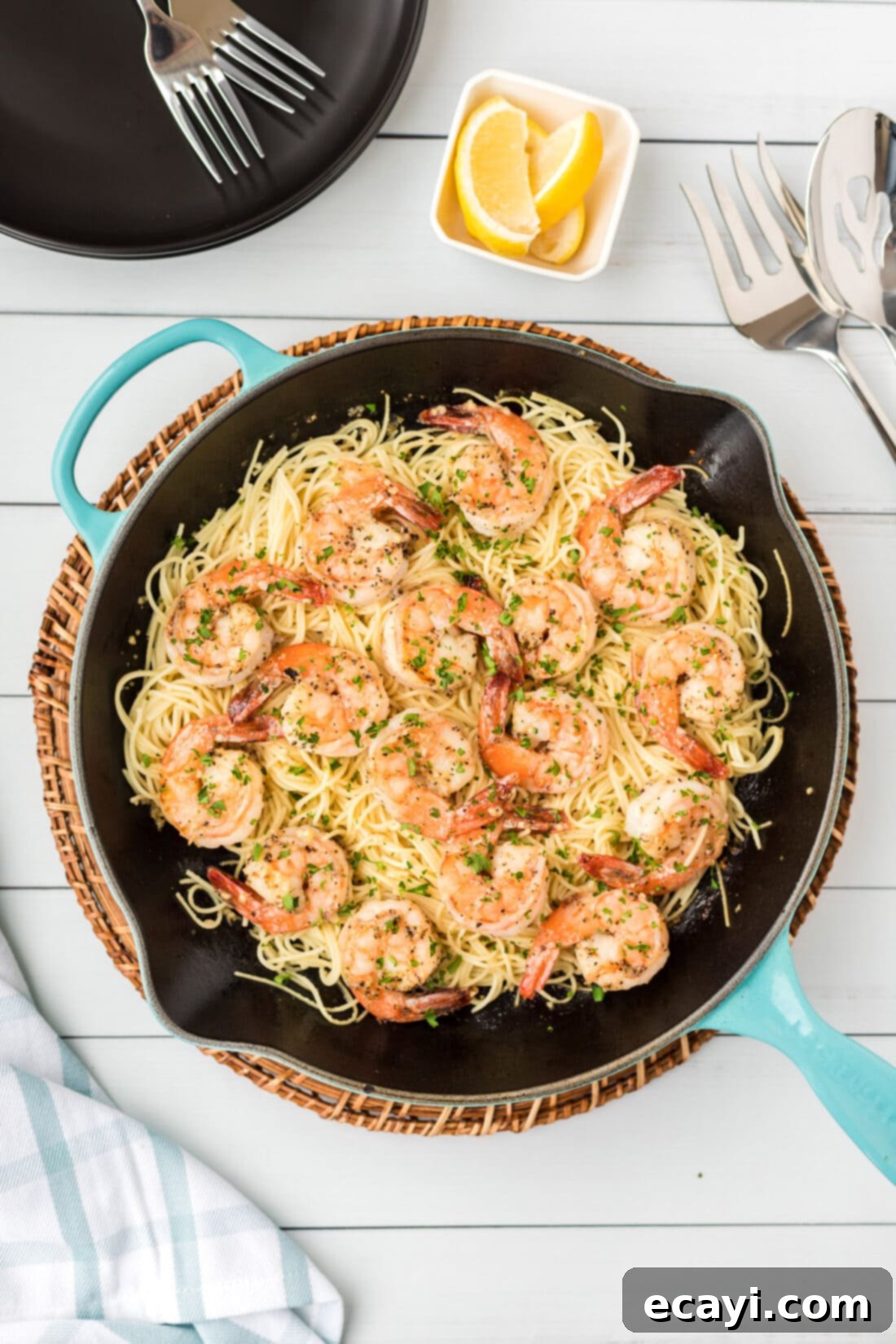
Why This Recipe Is a Must-Try
Our Shrimp Scampi Pasta isn’t just another dinner recipe; it’s a testament to how quick, fresh ingredients can transform into an extraordinary meal. This dish is designed for efficiency and maximum flavor, making it a perfect choice for busy evenings when you want something special without spending hours in the kitchen. Starting with plump, extra-large raw shrimp and culminating in a divine, glossy garlic butter sauce, this shrimp pasta recipe beautifully marries two beloved components. It delivers an incredibly tasty dish in around 25 minutes total, making it faster than takeout and infinitely more satisfying. Its simplicity doesn’t compromise on taste; every forkful is bursting with bright, savory flavors that will have you coming back for more. Plus, it looks effortlessly gourmet, making it ideal for entertaining while keeping your stress levels low.
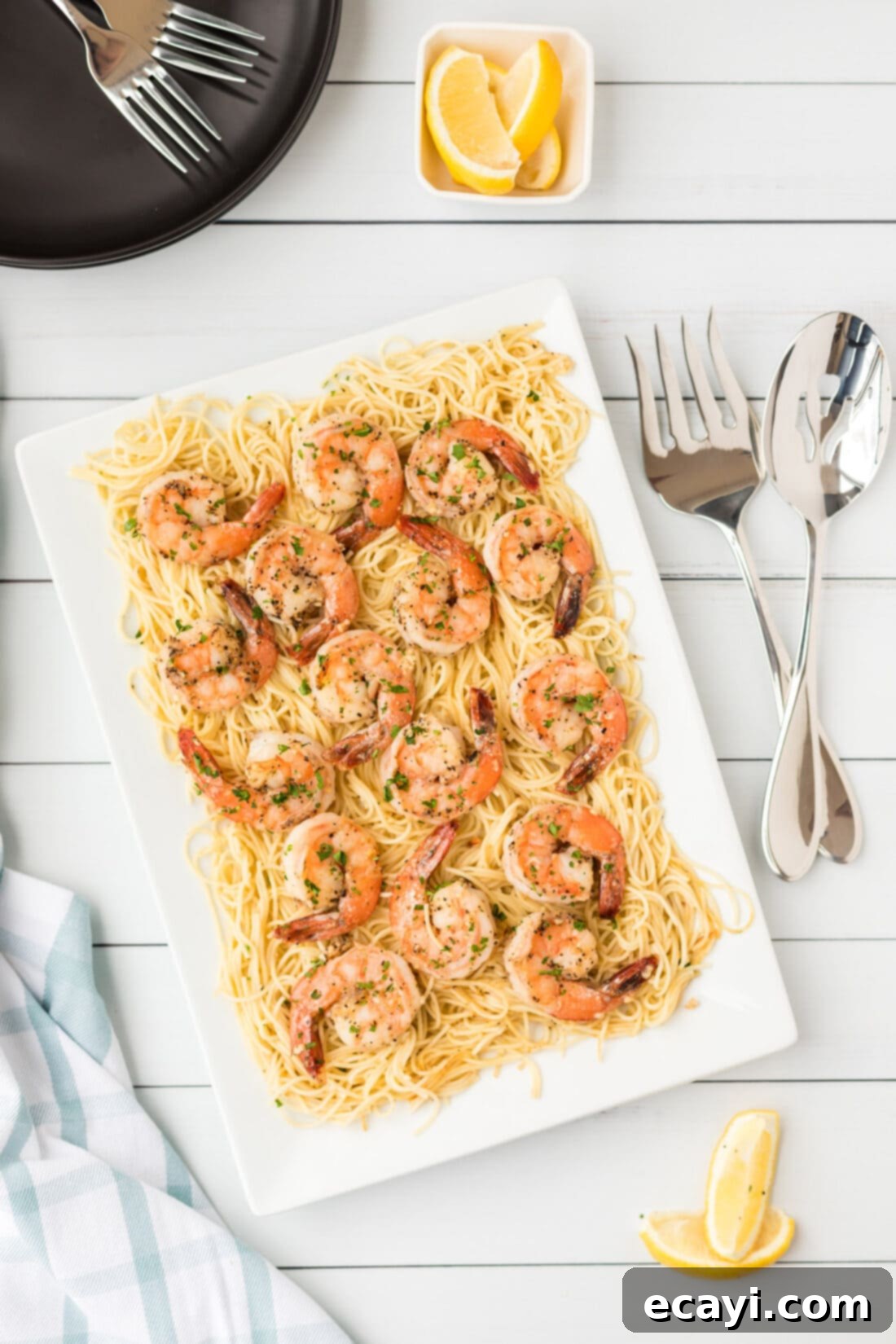
Key Ingredients for Flavorful Shrimp Scampi Pasta
To craft this exceptional Shrimp Scampi Pasta, you’ll need a handful of fresh and simple ingredients. Each component plays a vital role in building the layered flavors that make this dish so special. Below, we’ll dive into the details of what you’ll need and offer some helpful tips for substitutions and best practices. All precise measurements, ingredients, and detailed instructions can be found in the printable recipe card at the very end of this post.
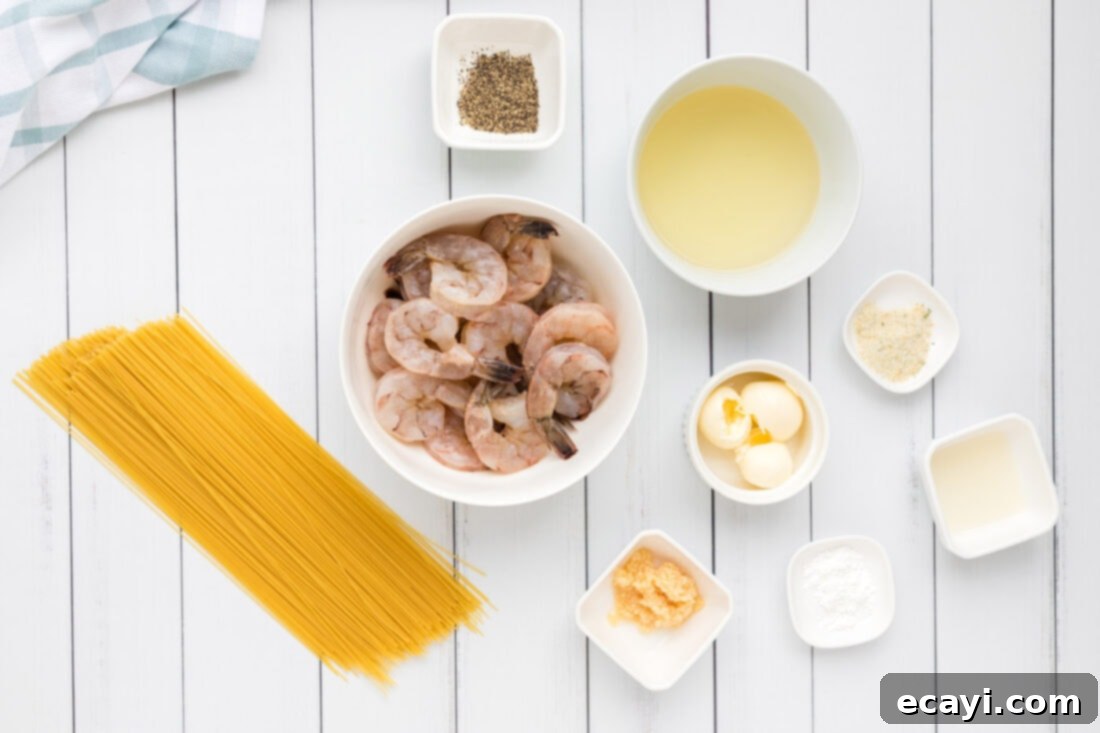
Ingredient Spotlight & Expert Substitutions
Let’s take a closer look at the stars of our Shrimp Scampi Pasta and discuss how to get the most out of them, along with smart substitution ideas.
PASTA – For this recipe, we highly recommend using delicate angel hair pasta. Its thin strands absorb the rich garlic butter sauce beautifully, creating a harmonious bite with the tender shrimp. However, this dish is versatile! If you prefer a different texture, feel free to substitute with other thin pasta varieties such as linguine or thin spaghetti. Even fettuccine can work if you enjoy a heartier noodle. The key is to choose a pasta that will effectively carry the sauce without overpowering the shrimp.
SHRIMP – The quality of your shrimp makes a significant difference. We find that extra-large raw shrimp are ideal for shrimp scampi pasta. Their substantial size ensures they don’t get lost among the pasta strands and hold up well to sautéing. While any size shrimp will work, larger shrimp tend to be more succulent. We chose to keep the tails on for a more appealing presentation, which also makes them easier to pick up when eating. However, you can certainly remove the tails before cooking if you prefer. Finding peeled and deveined shrimp with tails on can sometimes be challenging, so we often opt to peel and devein our own fresh shrimp. If convenience is key, pre-peeled and deveined shrimp (with or without tails) are perfectly fine to use.
WINE – A dry white wine is essential for developing the deep, nuanced flavor of the scampi sauce. Excellent choices include Sauvignon Blanc, Chardonnay, or Pinot Grigio. These wines add a delightful acidity and complex notes that cooking wine simply cannot replicate. For the best flavor, we strongly recommend using a real drinkable wine rather than designated “cooking wine,” which often contains added salt and preservatives that can alter the taste of your dish. If you prefer to keep the dish alcohol-free, a good quality chicken broth or even vegetable broth can be used as an effective substitute, though the flavor profile will be slightly different.
GARLIC – Freshly minced garlic is non-negotiable for authentic scampi flavor. Avoid pre-minced garlic in jars if possible, as it lacks the vibrant punch of fresh cloves. The more garlic, the better, in our opinion!
LEMON JUICE – Just like garlic, fresh lemon juice is crucial. It adds a bright, zesty tang that cuts through the richness of the butter and elevates all the other flavors. Bottled lemon juice pales in comparison to the vibrant taste of freshly squeezed lemon.
BUTTER – Unsalted butter is preferred, as it allows you to control the saltiness of the dish. It forms the rich base of our sauce, providing a luxurious mouthfeel and carrying the flavors beautifully. If you only have salted butter, simply adjust the amount of garlic salt you add.
CORNSTARCH – A small amount of cornstarch helps to slightly thicken the sauce, giving it that perfect clingy consistency that coats the pasta and shrimp without being too heavy. It’s a secret weapon for a glossy, restaurant-quality sauce.
Effortless Steps to Prepare Shrimp Scampi Pasta
These step-by-step photos and detailed instructions are provided to help you visualize each stage of making this delicious recipe. For a convenient printable version of this recipe, complete with precise measurements and comprehensive instructions, please Jump to Recipe at the bottom of this post.
- Prepare the Pasta: Begin by cooking your chosen pasta, such as angel hair, according to the package directions until it is al dente. Once cooked, drain the pasta and immediately rinse it under cool water to halt the cooking process and prevent it from sticking together. Set it aside while you prepare the shrimp and sauce.
- Clean and Dry Shrimp: Rinse the raw shrimp thoroughly under cold water. Pat them completely dry with paper towels. This step is crucial for achieving a good sear and preventing the shrimp from steaming instead of sautéing.
- Season the Shrimp: In a bowl, season the dried shrimp generously with garlic salt and black pepper. Toss gently to ensure all shrimp are evenly coated. Set them aside for a moment.
- Initiate the Sauce: In a large skillet over medium heat, combine the dry white wine, minced garlic, fresh lemon juice, and unsalted butter. Stir gently until the butter melts and the mixture warms. Once the sauce begins to bubble gently, reduce the heat to medium-low. Allow the mixture to simmer and reduce by approximately one-third. This reduction process concentrates the flavors and usually takes about 5 minutes.

- Thicken the Sauce: Evenly sprinkle the cornstarch over the hot, simmering mixture in the skillet. Stir continuously with a whisk or spoon for about 3-4 minutes, until the sauce begins to thicken slightly and achieve a desirable consistency that will beautifully coat the pasta and shrimp.
- Cook the Shrimp: Carefully add the seasoned shrimp to the skillet with the thickened sauce. Spread them in a single layer as much as possible. Cook the shrimp for approximately 2 minutes per side, or until they turn opaque and pink. Be careful not to overcook them, as shrimp can become rubbery very quickly.

- Rest the Shrimp: Once the shrimp are perfectly cooked, turn off the heat. Using tongs or a slotted spoon, carefully remove the cooked shrimp from the skillet and transfer them to a plate or bowl. Cover them loosely to keep them warm while you finish the pasta.
- Combine and Serve: Add the pre-cooked and drained angel hair pasta directly into the skillet with the remaining scampi sauce. Toss the pasta thoroughly to ensure it is completely coated with the flavorful sauce. Transfer the saucy pasta to a large serving platter and artfully arrange the warm shrimp on top. Serve immediately and enjoy your homemade Shrimp Scampi Pasta!
Frequently Asked Questions & Expert Tips for Success
Absolutely! Frozen shrimp are a convenient option. If you’re using frozen shrimp, the most important step is to thaw them completely before you begin cooking. Transfer them to the refrigerator overnight, or for a quicker method, place the frozen shrimp in a colander and run cold water over them for about 10-15 minutes until fully thawed. Once thawed, pat them very dry with paper towels to remove excess moisture, which helps them sear better and prevents the sauce from becoming watery.
If you prefer to make this dish alcohol-free or simply don’t have white wine on hand, chicken broth makes an excellent substitute. It will still provide a savory liquid base for the sauce. You can also use vegetable broth for a vegetarian option. The flavor profile will be slightly different from using wine, but it will still be incredibly delicious. Ensure you choose a low-sodium broth to control the overall saltiness of your dish.
To store any leftover Shrimp Scampi Pasta, transfer it to an airtight container and keep it refrigerated for 3-4 days. When reheating, you might notice that the butter in the sauce has separated and solidified in the fridge. To restore the sauce’s smooth consistency, reheat the pasta gently on the stovetop over medium-low heat or in the microwave. As it warms, add a splash of water or chicken broth (about 1-2 tablespoons) and stir well. This will help loosen the sauce and bring it back to its original silky texture.
If you prefer a thicker sauce, you can increase the cornstarch by another ¼ to ½ teaspoon, dissolving it in a tablespoon of cold water before adding it to the simmering sauce. For a thinner sauce, simply add a bit more white wine (or chicken broth) or a splash of pasta water until it reaches your desired consistency.
Absolutely! This recipe is incredibly adaptable. Consider adding some thinly sliced cherry tomatoes, a handful of fresh spinach (stir it in at the very end until just wilted), or even some sautéed asparagus tips or bell peppers for extra nutrition and color. Add these vegetables when you’re reducing the sauce or just before adding the shrimp.
Freshly chopped parsley is a classic garnish that adds a pop of color and herbaceous freshness. A sprinkle of red pepper flakes can introduce a subtle heat, and a grating of Parmesan cheese (though not traditional for scampi, many enjoy it) can add a salty, umami kick. A final squeeze of fresh lemon juice just before serving brightens the entire dish.
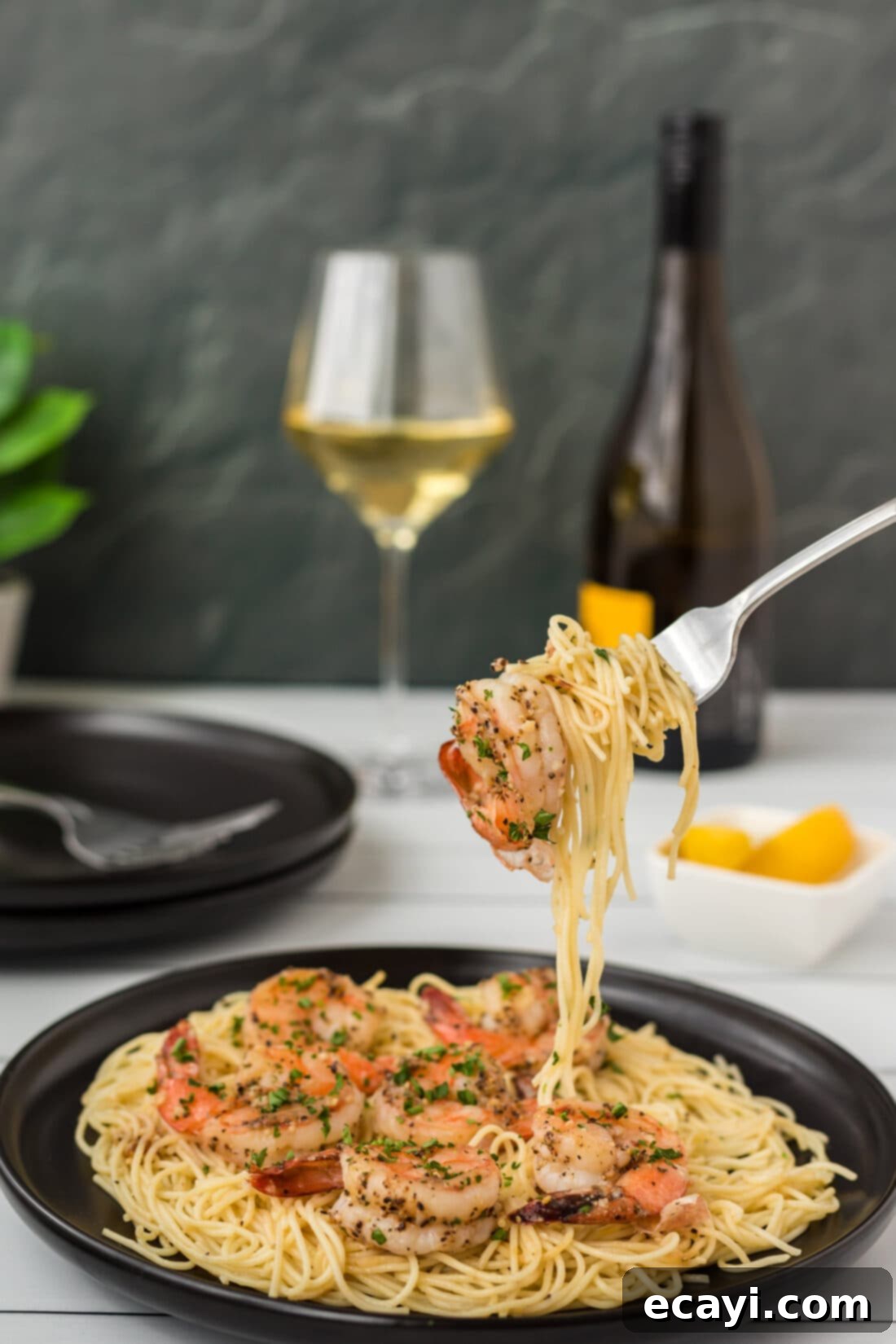
Serving Suggestions to Complete Your Meal
While Shrimp Scampi Pasta is a complete and satisfying meal on its own, you can elevate your dining experience with a few thoughtful additions. Serve it simply with a sprinkle of freshly chopped parsley for a burst of color and herbaceous freshness. To soak up every last drop of that incredible garlic butter sauce, offer some crusty bread or garlic bread alongside. A light, leafy side salad with a vinaigrette dressing provides a refreshing contrast to the richness of the pasta. For a truly Italian-inspired meal, pair it with a crisp, dry white wine similar to the one used in the sauce, or a sparkling water with lemon for a non-alcoholic option. Enjoy this delightful dish with friends and family for an unforgettable meal!
More Irresistible Shrimp Recipes to Try
If you’ve fallen in love with shrimp like we have, you’re in luck! There are countless delicious ways to prepare this versatile seafood. Here are some more of our favorite shrimp recipes that are perfect for any occasion:
- Zesty Shrimp Fajitas
- Grilled Shrimp Kabobs
- Crispy Popcorn Shrimp
- Spicy Blackened Shrimp
- Flavorful Chile Lime Shrimp
- Elegant Butterfly Shrimp
- Bright Citrus Pepper Shrimp
I absolutely adore spending time in the kitchen, experimenting with new flavors, and sharing my culinary discoveries with all of you! To make sure you never miss out on a delicious new recipe, I offer a convenient newsletter that delivers fresh ideas right to your inbox every time a new post goes live. Simply subscribe here and start receiving your free daily recipes!
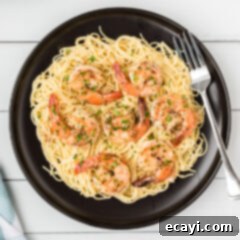
Shrimp Scampi Pasta
IMPORTANT – There are often Frequently Asked Questions and Expert Tips within the blog post that you may find incredibly helpful for optimizing your cooking experience. Simply scroll back up to read them!
Print It
Pin It
Rate It
Save ItSaved!
Ingredients
- 1 pound extra large raw shrimp peeled, deveined, tails kept on (or removed, as preferred)
- ½ teaspoon garlic salt
- ½ teaspoon black pepper
- ½ pound angel hair pasta (or linguine, thin spaghetti)
- ½ cup dry white wine (e.g., Sauvignon Blanc, Chardonnay, Pinot Grigio)
- 1 Tablespoon minced garlic (freshly minced is best!)
- 1 Tablespoon lemon juice (freshly squeezed)
- 3 Tablespoons unsalted butter
- ½ teaspoon cornstarch
Essential Equipment
-
Large skillet
-
Large saucepan
Helpful Notes & Pro Tips
- For a richer, slightly thicker sauce, you can incrementally increase the amount of butter by 1 tablespoon and/or add an additional 1/4 cup of white wine to deepen the flavor.
- Always opt for a dry white wine like Sauvignon Blanc, Chardonnay, or Pinot Grigio. These lend the best flavor and acidity to the sauce. We highly recommend using real wine rather than “cooking wine” to avoid unwanted additives and ensure superior taste.
- If you prefer an alcohol-free dish, chicken broth is an excellent substitute for the white wine. It provides a savory base without altering the texture significantly.
- We chose to keep the tails on our shrimp for aesthetic reasons and ease of handling while eating. However, you can certainly remove them before cooking if you prefer. While it can be tricky to find peeled and deveined shrimp with tails still on, you can always peel and devein fresh shrimp yourself, or simply use peeled, deveined shrimp with tails removed for convenience.
- Avoid overcooking the shrimp! They cook very quickly (2 minutes per side is usually sufficient). Overcooked shrimp become tough and rubbery.
- For an extra layer of flavor, consider adding a pinch of red pepper flakes to the sauce along with the garlic for a subtle kick.
- A final squeeze of fresh lemon juice over the finished dish just before serving can brighten all the flavors.
Detailed Instructions
-
Cook your preferred pasta (angel hair, linguine, or thin spaghetti) according to the package directions until it reaches an al dente texture. Immediately drain the pasta and run it under cool water to stop the cooking and prevent sticking. Set aside.
-
Rinse the raw shrimp thoroughly under cold running water. Pat them completely dry with paper towels to ensure they will sear nicely and not steam.
-
Season the dried shrimp generously with garlic salt and freshly ground black pepper. Toss to coat evenly. Set aside.
-
In a large skillet, combine the dry white wine, minced garlic, fresh lemon juice, and unsalted butter. Heat this mixture over medium heat, stirring until the butter melts and the liquids begin to bubble gently. Once bubbling, reduce the heat to medium-low and allow the sauce to simmer and reduce in volume by about one-third, which typically takes around 5 minutes. This concentrates the flavors.
-
Sprinkle the cornstarch evenly over the hot mixture in the skillet. Stir continuously with a whisk or spoon for approximately 3-4 minutes until the sauce slightly thickens and achieves a glossy, luscious consistency.
-
Add the seasoned shrimp to the skillet. Cook for about 2 minutes per side, or until the shrimp turn pink and opaque. Be very careful not to overcook the shrimp, as they can become tough quickly.
-
Once cooked, turn off the heat. Remove the shrimp from the skillet and place them on a plate or in a bowl. Cover loosely to keep them warm.
-
Add the pre-cooked pasta directly to the skillet with the remaining scampi sauce. Toss the pasta thoroughly to ensure every strand is beautifully coated. Transfer the pasta to a serving platter and arrange the warm shrimp on top. Serve immediately and savor every delicious bite!
Nutrition Information
The recipes on this blog are carefully tested with a conventional gas oven and gas stovetop to ensure consistent results. It’s important to acknowledge that some ovens, especially older models, can cook and bake inconsistently. Using an inexpensive oven thermometer can be a great way to verify that your oven is truly heating to the proper temperature. If you’re utilizing a toaster oven or a countertop oven, please remember that their heat distribution might differ from a conventional full-sized oven, and you may need to adjust your cooking or baking times accordingly. For recipes prepared with specialty appliances like pressure cookers, air fryers, or slow cookers, a direct link to the specific appliance models we use is typically provided within each respective recipe. When it comes to baking recipes where measurements are given by weight, please be aware that using cup measurements instead may lead to varying results, and we cannot guarantee success with alternative measurement methods.
